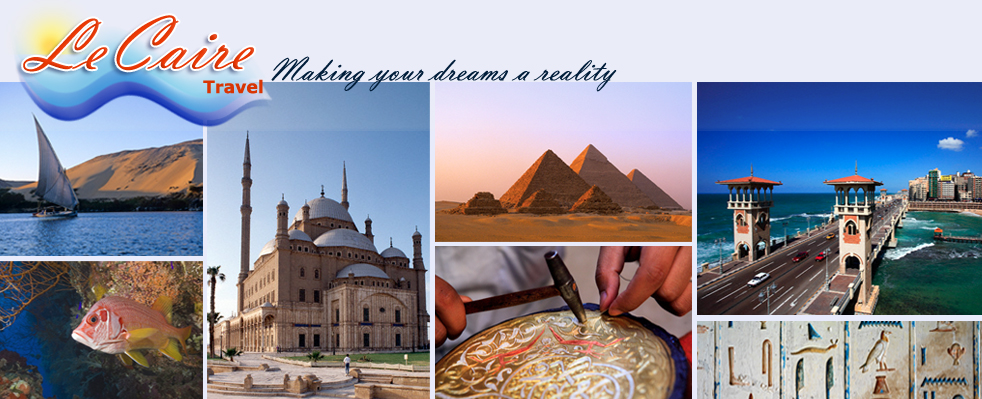|
|
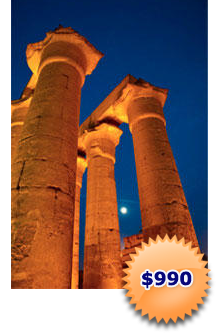 |
Superior Offer
09 Nights / 10 Days
Discover the Difference |
|
|
|
 |
| |
|
 |
Alexandria Sights
|
|
 |
|
| |
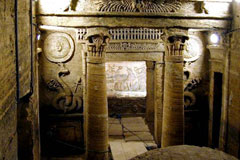 Catacombs of Kom El Shokafa Catacombs of Kom El Shokafa
The catacombs are the most interesting of Alexandria. They were built in the 2nd century AD during the Roman era. Its architecture is a unique combination of both Egyptian and Greco-Roman art. They probably belonged to a one family. The burials are of 3 levels at the depth of 30 meters (100 feet) but the lowest level is unfortunately flooded with water and inaccessible.The entrance is accessible by climbing down a spiral staircase round a shaft through which the body of the deceased was lowered by robes.The tombs have a banquet hall furnished with rock-cut benches to accommodate visitors who come to visit the departed and dine.The tombs were excavated accidentally in 1900 when a donkey cart stumbled in a pit leading to the monument.
The tombs are maybe the last in Egypt to bear the theme of the ancient Egyptian pagan beliefs. |
 
|
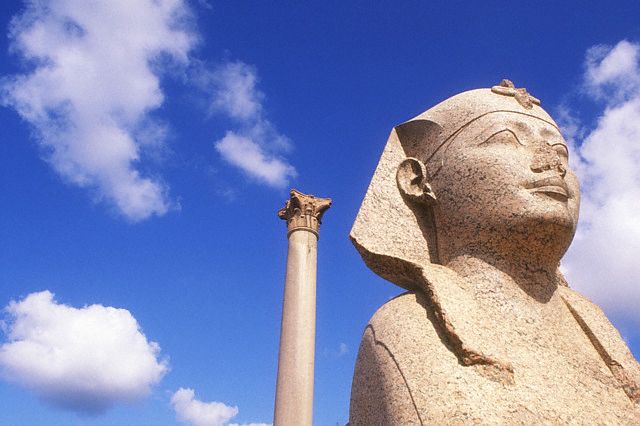 Pompey's Pillar Pompey's Pillar
An approximately 25m red Aswan granite column with a circumference of 9m, was constructed in honor of the Emperor Diocletain. Originally from the temple of the Serapis, it was once a magnificent structure rivaling the Soma and the Caesareum. Nearby are subterranean galleries where sacred Apis bulls were buried, and three sphinxes. After his defeat by Julius Caesar in the civil war, Pompey fled to Egypt where he was murdered in 48 BC; mediaeval travelers later believed he must be buried here, and that the capital atop the corner served as a container for his head. In fact, the pillar was raised in honor of Diocletain at the very end of the 4th century. Diocletain captured Alexandria after it had been under siege. The Arabs called it "Amoud el-Sawari", Column of the Horsemen. The Pillar is the tallest ancient monument in Alexandria. |
 
|
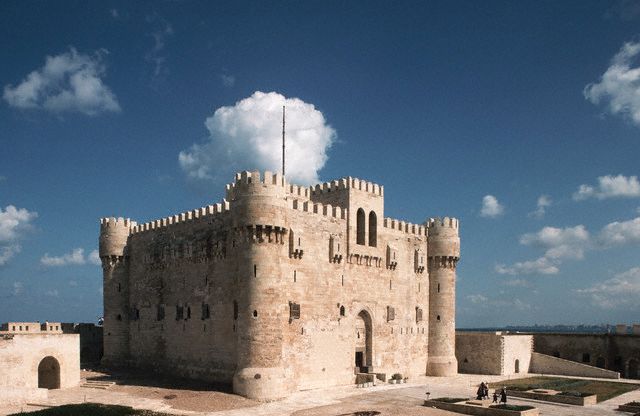 Qait Bay Fort Qait Bay Fort
The fort was built in the 1480’s by the Egyptian Mamelouk Sultan Qaitbay on the spot of Alexandria’s ancient lighthouse (which was one of the Seven Wonders of the World).
Qaitbay built this Citadel to strengthen the north of Egypt mainly against the Ottomans whose power was increasing in the Mediterranean. It was said that Qaitbay spent more than a hundred thousand Dinars for the work of this citadel. |
 
|
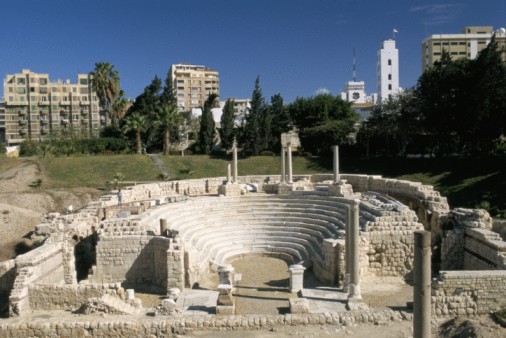 The Roman Amphitheatre The Roman Amphitheatre
very town in ancient Rome had an amphitheatre, which means, "double theatre". They were grand and impressive, shaped in a half circle, open to the sky, and might have held 100.000 people. The stage had no curtain; it was just a stone platform.
Imagine yourself in ancient Alexandria, in the Roman theatre on a hot afternoon. All you can smell is the Mediterranean mist; all you can see are wild beasts, driven in through the tall doorway, and the fighters coming in from all around the floor. Famous jockeys and gladiators are walking in, and then the excitement begins.
The Roman theatre is located in the modern area of Kom El-Dikaa, which is almost in the centre of the city of Alexandria, Egypt bordered by Horrya street from the north, Nabi Daniel street from the west, Abdel Moneim street from the south, and Saphia Zaghloul street from the east.
Dating from the 2nd century A.D it has a large auditorium, about 42m in diameter. The outer face of this building was probably adorned with columns located in several storey. In later times the theatre was rebuilt and its auditorium was diminished to 33.5 m in diameter. It then counted 16 rows of marble seats |
 
|
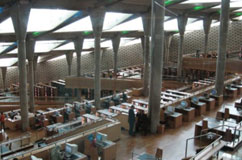 Alexandria Library Alexandria Library
The Royal Library of Alexandria, or Ancient Library of Alexandria, in Alexandria, Egypt, was probably the largest, and certainly the most famous, of the libraries of the ancient world. It flourished under the patronage of the Ptolemaic dynasty and existed, and functioned as a major center of scholarship, at least until the time of Rome's conquest of Egypt, and probably for many centuries thereafter.Generally thought to have been founded at the beginning of the third century BC, the library was conceived and opened either during the reign of Ptolemy I Soter or during the reign of his son Ptolemy II. Plutarch (AD 46–120) wrote that during his visit to Alexandria in 48 BC, Julius Caesar accidentally burned the library when he set fire to his own ships to frustrate Achillas' attempt to limit his ability to communicate by sea.[citation needed] According to Plutarch's account, this fire spread to the docks and then to the library.
However, this version of events is not confirmed in contemporary accounts of Caesar's visit. In fact, it has been reasonably established that segments of its collection were partially destroyed on several occasions before and after the first century BC. A modern myth (no older than the late eighteenth century) attributes the destruction to Coptic Christian Archbishop Theophilus of Alexandria in 391, who called for the destruction of the Serapeum; but in fact there was no connection between the library and the Serapeum, and no good historian of late antiquity takes the claim seriously. A more credible version of the story, not recorded till the thirteenth century, blames the Muslim sacking of Alexandria in 642.[1]
Intended both as a commemoration and an emulation of the original, the Bibliotheca Alexandrina was inaugurated in 2002 near the site of the old library |
 
|
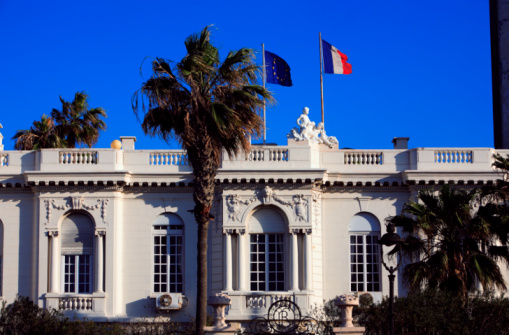 Alexandria National Museum Alexandria National Museum
Opened in 2003, the Alexandria National Museum displays some 1,800 artifacts discovered in and around Alexandria, Egypt. Many of the artifacts were not previously on display, but hidden in the storage rooms of other museums.The National Museum is housed in a restored Italian-style palace (Al-Saad Bassili Pasha Palace, built 1926) with three floors. he first level, with dark blue walls reflecting the Egyptian symbolic color of the afterlife, is dedicated to the Pharaonic period. On display are several notable statues, including portraits of Menkaure (builder of the third Giza), Akhenaton (Amenhotep IV) and the female pharaoh Hatshepsut.
There is also an interesting replica of the sort discovered in the Valley of the Kings, complete with a mummy and original funerary treasures.
The middle level displays artifacts from the Greco-Roman period, during which Alexandria flourished, such as figurines of Greek women and a majestic bust of the bearded god Serapis. Also on this level are finds from recent underwater excavations conducted around Alexandria, including several notable stone statues.
The top floor displays Coptic and Islamic treasures, illustrating the rich heritage of these two faiths that are still alive and well in Egypt. There are icons of Christ and the Virgin Mary, carved tombstones and clothes with silver and gold crosses. Notable among the Islamic objects are 162 coins minted in Alexandria and religious supplies such as incense burners, chandeliers and pottery. |
 
|
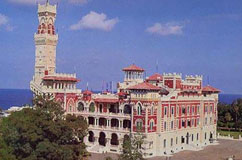 Montazah Royal palace Garden Montazah Royal palace Garden
Though the gardens are a part of the more than three hundred and fifty acre grounds of the large royal home known as the Muntazah Palace, the Montazah Royal Gardens take up more than half of the property.The palace was constructed in the 1800s by Abbas II, and though additions have been made to the impressive structure (including two hotels) the majority of the area is free to use by the people of the city.Montazah Royal Gardens are situated along the shore as well, which means access to the lovely beaches and warm Mediterranean Sea waters nearby.
In fact, the property includes an enclosed cove, with a specially constructed bridge that permits the small pleasure boats to come easily in and out of the bay without any concerns of the rougher waters beyond the reach of the land.
Additionally, there is a charming lighthouse to help guide boats safely past the cove.
The Montazah Royal Gardens are a bit unique where city parks and public spaces are concerned as they are rigorously landscaped, and well-stocked with benches and wading or swimming pools that are open for the public to enjoy. |
|
|
|
|
|
|
|
|
 |
|
